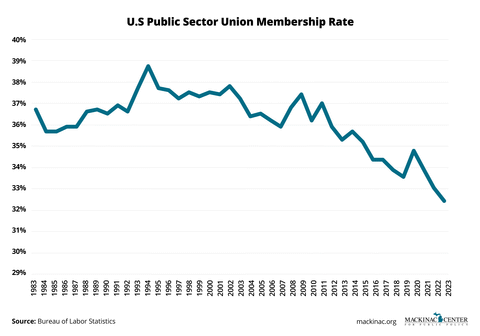Union membership reaches a 40-year low
The last 15 years have seen the number of government union members drop by 900,000
The annual survey report from the federal government shows that the union membership rate in 2023 dropped to the lowest ever recorded.
The share of workers who are members of a labor union is down to 10%, which is half the rate it was in 1983, the first year of the survey. At the time, there were 17.7 million union workers. That’s down to 14.4 million today.
Since 1983 the population of the United States and the number of people in the workforce have both increased. This means the rate of union membership has plummeted.
For private sector workers, the rate of union membership has slowly and steadily declined from almost one-fourth of workers in the 1970s to 6% in 2023. While the number of private union members increased last year, so did the number of overall employees.
The big change in recent years has been in public sector union membership.
From 1979 to 2011, the share of government workers who were members of a union held steady at around 37%. In 2011 a series of states began passing right-to-work laws, giving workers the right to opt out of union membership without losing their jobs. This started a downward trend in union membership. Then in 2018 the U.S. Supreme Court ruled in Janus v. AFSCME that all public sector workers nationwide had right-to-work status.
Since 2011 the share of government workers deciding to remain as union members has declined from 37% to 32.5%. That equates to 900,000 fewer members. The number of public sector union members (7.0 million) is now well below the number of private sector union members (7.4 million).
Union losses since the Janus decision are likely understated. A 2023 report from the Mackinac Center for Public Policy analyzed the different ways to measure changes in union membership. It found that public records requests and union financial reports showed even heavier losses for government unions than surveys. State, school and local unions have seen around 20% of their members - one out of every five - decline to join.
Union membership in Michigan has dropped sharply. It stands at 12.8% of employed individuals, down from more than 30% in 1983. From 2022 to 2023, unions lost 25,000 members. This dropped Michigan from the 11th-most unionized in 2022 to the 12th-most unionized in 2023. Michigan was a top 10 state for union membership every year it was measured up until 2020.
Michigan Capitol Confidential is the news source produced by the Mackinac Center for Public Policy. Michigan Capitol Confidential reports with a free-market news perspective.



 Steelworkers Union hit with unfair labor practice charges by Viking Corporation employee
Steelworkers Union hit with unfair labor practice charges by Viking Corporation employee
 As Janus anniversary nears, public workers retain right to union representation
As Janus anniversary nears, public workers retain right to union representation
 State teachers union loses members, revenue
State teachers union loses members, revenue